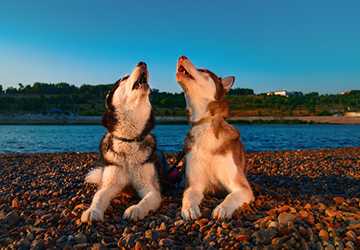Dogs howling at sirens confuses many pet owners and observers. This behaviour is expected in urban environments and is a fascinating aspect of dog behaviour and alarm. To understand why dogs howl at sirens, it's essential to understand their instincts and methods of communication. Let's explore the explanations for a dog howling to shed some light on this fascinating behaviour.
Dogs howling at sirens confuses many pet owners and observers. This behaviour is expected in urban environments and is a fascinating aspect of dog behaviour and alarm. To understand why dogs howl at sirens, it's essential to understand their instincts and methods of communication. Let's explore the explanations for a dog howling to shed some light on this fascinating behaviour.

1. Connect with wolf ancestors:
Dogs' howling response can be traced back to their wolf ancestors. Wolf howls are a form of long-distance communication used to rally wolves or indicate their location. Domestic dogs retain this instinctive behaviour. The sound of a siren is high-frequency and fluctuating, which may resemble a howl and trigger a similar response in dogs.
2. Reaction to high pitch:
Dogs' hearing is much more sensitive than humans. For some dogs, high-pitched noises such as sirens can be exceptionally irritating or stressful. The intensity and pitch of a siren can trigger a dog's instinctive response, causing them to howl in response.
3. Territorial behaviour and communication:
Howling in response to an alarm can also signify territorial behaviour. Dogs may interpret such unfamiliar loud noises as an intrusion into their territory or communication from other "creatures." Responding with a howl may be their way of announcing their presence or trying to communicate with what they perceive to be another being.
4. Social reactions and group behaviour:
Another reason why dogs howl at sirens has to do with their social nature. Dogs, like their wolf ancestors, are social animals and often respond to the howls of other dogs. The siren triggers a howl response in the dog, causing other nearby dogs to join in, starting a chain reaction. This group behaviour is a natural social response and is part of the explanation for dog howling.
5. Stress or discomfort:
In some cases, the sound of a siren can cause stress or discomfort to a dog, leading to howling. This reaction may be caused by the siren's loudness or specific frequency, which may be uncomfortable for the dog's sensitive ears. It is a form of expressing discomfort or seeking comfort from fellow humans.
6. Answer nature’s sawing call:
Some experts believe the sirens may tap into a dog's basic senses and appear like nature's barks. The sound may awaken an ancient instinctive urge to respond to the call of another dog, perhaps a distant pack member. This idea relates to their genetic roots and the pack mentality embedded in their behaviour and provides a deeper understanding of why dogs scream when frightened.
7. Imitate or join in the conversation:
Dogs may only pounce on public events they think will make noise. Like people singing, dogs can purr beside the alarm clock for support. This behaviour should be part of their social and intuitive nature, adding another layer to the interpretation of the dog crying by verbally communicating their current situation.
8. Racial Prejudice:
Some types of dogs are more prone to crying than others due to genetic predispositions and proven working abilities. Dogs who tend to vocalize, such as huskies, beagles, and bloodhounds, are more likely to howl in response to sirens. Genetics also influence howling, as this breed-specific tendency provides information about the dog's behaviour and alarm.
9. Effects of environment and domestication:
Its acclimation and environment influence how a dog responds to sirens. Dogs react more strongly to noise in big cities; for example, some dogs, such as sirens, maybe more desensitized and less likely to cry, while dogs less acclimated to their environment may react louder. This diversity demonstrates how training and ecological variables influence grooming in whining dogs.

10. Communication with human counterparts:
Sometimes, dogs cry when they become alarmed while talking to their human friends. They may tell their owners something they find exciting or different. This behaviour demonstrates the communicative nature of howling, with dogs using vocalizations to communicate with their human family members.
11. Tactile tasks:
For some dogs, the auditory sensation of an alarm can be fascinating or irritating. This sensory stimulation may produce a howling response as a sign of excitement or interest. As part of the behavioural response to external stimuli, it shows how the dog processes and responds to these stimuli. A standard theory is that dogs instinctively respond to high-pitched alarm calls by howling. Sirens trigger physiological responses derived from their ancestors by emitting frequencies like the howls of dogs or wolves. Wolves and other dogs howl in the wild to signal their presence to other pack members. Another possible explanation is that alarms cause inconvenience or confusion to some dogs. Loud, unexpected, and often confusing alarm sounds can cause stress or distress in some dogs. As they try to adjust to this pressure, they may express it by complaining. Social influences within the family or neighbourhood can also play a role. Dogs are easily affected by their environment and behave differently than dogs. If one dog in the home starts screaming due to an alarm, it could start a chain reaction involving multiple dogs. Friendliness and solidarity between dog’s drive this gathering and whining behaviour. In summary, understanding why dogs howl in response to sirens requires considering various factors, from their ancestral connection to wolves and responses to high-pitched sounds to territorial behaviour, social responses, and expressions of stress or discomfort. This behaviour is a complex combination of intuitive, communicative, and emotional responses.



